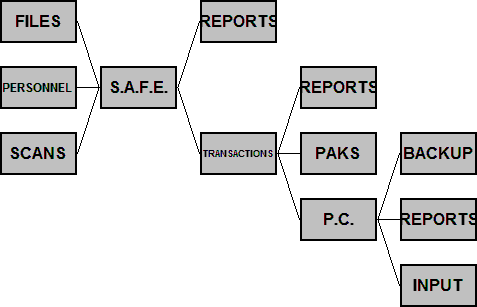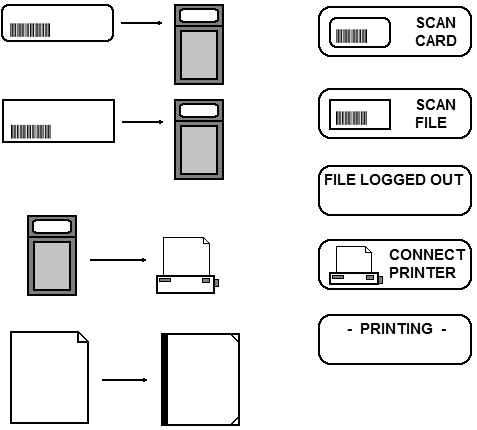| 8k | |
| 8k | |
| 16k | |
| 16k | |
| 32k | |
| 32k | |
| 64k | |
| 64k | |
| 128k | |
| 128k |
Note: These figures are examples only

This is not a manual but an information pack that fully describes what S.A.F.E. does.
Harvester Information Systems Limited,
Head Office and Development Centre:
Unit 1, Ealand Science Park,
Wharf Road, Ealand, South Humberside, DN17 4JW
TEL: 0724 710222 FAX: 0724 710951
S.A.F.E. is a compact and versatile new system from Harvester information Systems designed to help you keep control of your filing system. No longer will it be necessary to waste valuable time chasing that elusive file which no-one seems to know about. With S.A.F.E.. simply press a few buttons and find out who has taken it.
S.A.F.E. comprises the Psion P250 hand held computer, complete with housing and bar code reader. Each user is issued with a plastic identity card, which has a barcode. Every file registered on the system also has a barcode. When borrowing a file, a user will firstly scan their own barcode, then the code on the file. This automatically logs the file out. In addition to giving the whereabouts of current files S.A.F.E. will also give details of the previous loans, and details of registered users and files on the system.
S.A.F.E. is remarkable in that it incorporates a variety of security features. For example, there are different access levels for users wishing to take out files. Confidential files can be given maximum security and restricted to the most trusted employees. Where less confidentiality is required, a lower grade can be assigned to the file enabling a greater number of users to gain access. Another useful security feature of the system is the facility to limit access to personnel details to only certain users. If it is necessary to change details, for example giving someone a higher security rating, this can only be achieved by a keyholder. To make such changes it is necessary for the user to open the housing, which is kept locked. Inside is situated a bar code which must be scanned before access to the records is given. This superb safeguard will prevent normal users from bypassing security procedures. The usefulness of S.A.F.E. to any office or business with a large filing system, is greatly enhanced by these security features.
S.A.F.E. is symbol driven for ease of use, and compatible with S.A.M.S.. For those users who want greater flexibility, a P.C. version is available, still incorporating the Psion P250 and barcode reader, but with P.C. software, making manipulation and analysis of data more simple. In fact, S.A.F.E. gives a full audit of who had what file, when, where from and for how long. Incomparable!
S.A.F.E. from Harvester Information Systems is an indispensable tool for anyone who needs to log the removal and return of files, or indeed any other barcoded items.
S.A.F.E. is a new way of keeping track of files or other barcoded items, which informs a system manager as to where files are at any time. Every system user is issued with an identity card, and when he or she wants to remove a file, a simple scan of their identity card, followed by the file is all that is required by the system. That removal is then logged and is only cancelled when the file is returned.
Each file has two special criteria - lease time, and access level. When you take a file out, you must return it within the time limit specified. If you do not, then a warning message will appear on reports generated.
The access level for each file is compared to the access level allocated to the user. If a user tries to remove a file above his or her level, a warning is displayed on the screen.
S.A.F.E. can also generate its own barcodes, so if you don't already have a system, you can create your own!
You can even link your S.A.F.E. unit to P.C. S.A.F.E., for even faster data processing and floppy disk beck-up storage. You will also have the advantage of a large screen and a QWERTY keyboard.
So, whichever system you buy, you really ARE buying a system, as either a portable unit, or a P.C. based processor.
S.A.F.E. is a portable or fixed system for keeping track of files or other barcoded items, which are accessed by users also identified by barcode. The items in question can be files, books or any other objects which can display, or already do display barcodes.
To achieve the optimum storage space, a 128k datapak would allow you to store about 200 users and approximately 3500 files.
S.A.F.E. can also print barcodes straight from the P250, so if you don't already have a barcode system on your files, you can easily create one.
As well as accepting most types of barcodes, S.A.F.E. can also efficiently print EAN-13 type codes - most commonly found on food stuffs, electrical and stationary products.
You can also use P.C. S.A.F.E. to enhance the system. It can be used to enter all the user and file data, and also print reports for personnel and files.
The P250 itself will provide four types of reports - files out (including those which should have been returned), files returned, authorised users, and registered files. These can all be printed direct from the P250.
S.A.F.E. is a total portable system, all in one unit.
| Data Input | 2 lines, 16 characters per line, full ascii alpha-numeric liquid crystal display, providing text and graphic prompting for user. | ||||||||||||||||||||
|---|---|---|---|---|---|---|---|---|---|---|---|---|---|---|---|---|---|---|---|---|---|
| Accepted codes | Infra red digital micro-switch controlled wand or moving beam laser diode bar-code scanner. | ||||||||||||||||||||
| Display | EAN 8, EAN 13, UPC, CODE 39, ITF, CODABAR, TELEPEN, MODIFIED PLESSEY, PLESSEY, CODE 128, also plastic covered and pattern obscured codes. | ||||||||||||||||||||
| Keyboard | 36 key keyboard allowing 78 alpha-numeric characters to be entered plus dedicated keys for SHIFT, DELETE, SPACE, ENTER and ON, also full cursor control, caps and number lock keys, and MODE key. | ||||||||||||||||||||
| Program | One system chip which monitors files taken and returned, prints reports and barcodes, displays users with files out, and restricts access to security coded files. | ||||||||||||||||||||
| System capability | Any number of S.A.F.E. units can connect to one master S.A.F.E. P.C. via a communications link. Data can then be received or transmitted to or from the P.C.. One portable S.A.F.E. unit can, however, manage a filing system independently, without ever needing a P.C. to link to. | ||||||||||||||||||||
| Construction | Detachable rugged plastic barcode reader, connected by 16 pin shielded connector to S.A.F.E. unit - tough plastic moulded casing, metal cased screen and protective cover for keyboard during operation. Also available; leather, belt mounted S.A.F.E. unit holder, leather wrist strap S.A.F.E. holder, extra battery packs. | ||||||||||||||||||||
| Dimensions | Length 142.00mm Width 78.00mm Depth 29.30mm Weight 225.00 grams | ||||||||||||||||||||
| Micro-processor | HD6303X processor | ||||||||||||||||||||
| Memory | 32 kbyte RAM, 128 kbyte EPROM for file data, 32 kbyte EPROM for system data. | ||||||||||||||||||||
| Datapak capacity | Key: Files Personnel
Note: These figures are examples only | ||||||||||||||||||||
| Datapaks | The datapaks used for data storage can be erased and re-used using an ultra-violet formatter. | ||||||||||||||||||||
| Power | 9 Volt battery or mains power adaptor | ||||||||||||||||||||
| Flow diagram | 
|
P.C. S.A.F.E. combines the power and versatility of the S.A.F.E. units, with the speed and capacity of the P.C.s. You can transmit and receive file and personnel data - enter all your file information on the P.C. and then simply down-load it to a S.A.F.E. unit.
P.C. S.A.F.E. can also generate complex columnised reports, and sort your file data into exactly the order you want. You can also search the file list for the name of the file you can't quite remember, utilising the excellent search features of P.C. S.A.F.E..
P.C. S.A.F.E. will run on any IBM or compatible, and comes on disc ready for immediate use. The two machines are joined with a communications link which will connect to any RS232 interface.
User / Computer flow diagram
